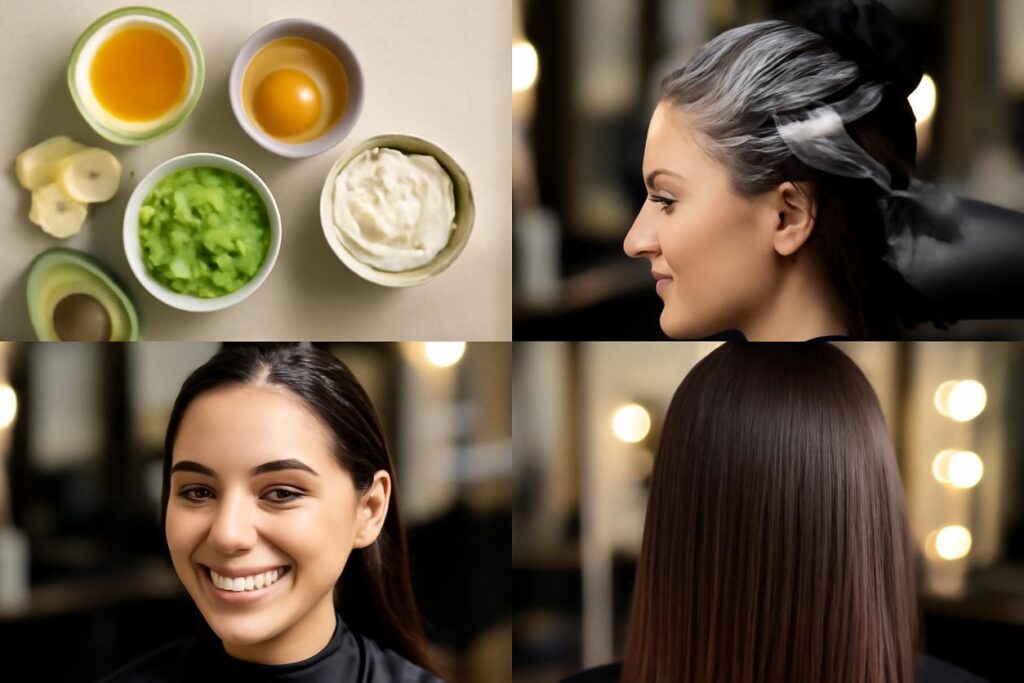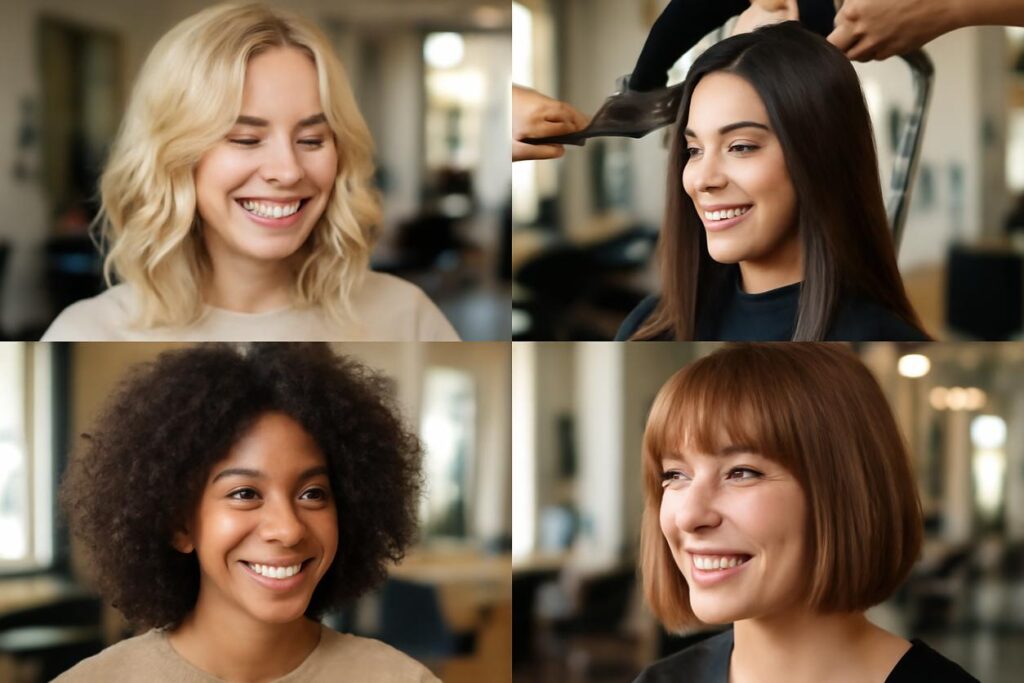Introduction: Why Knowing Your Hair Type Matters
We’ve all been there: a bathroom cabinet overflowing with products that promised miracles but delivered frustration. The truth is, there’s no single secret to perfect hair because there’s no single type of hair. Understanding the unique characteristics of your strands is the first and most crucial step toward ending the cycle of trial and error. Knowing the specific hair types and your own can transform your routine from a guessing game into a precise, effective strategy for health and vibrancy.
This guide is your texture-first playbook. We’ll move beyond just “straight” or “curly” to give you a complete picture of what your hair needs to thrive. We’ll link simple at-home tests with tailored daily routines and even explore how the food you eat can impact your hair’s health. By learning to identify your hair’s texture, porosity, and pattern, you can finally choose the right techniques and ingredients, saving you time, money, and a lot of bad hair days.
Decoding Your Hair: Structure, Self-Tests and Key Factors
Before you can care for your hair properly, you need to become a detective. Your hair leaves clues about its identity everywhere. Let’s start with a few simple tests you can do right now, followed by an explanation of what it all means.
Quick Self-Test: Easy At-Home Ways to Identify Your Hair
Grab a few clean, dry strands of your hair and let’s get started.
- The Strand Thickness Test: Roll a single strand of hair between your thumb and index finger. If you can barely feel it, you likely have fine hair. If you can feel the strand distinctly, you have coarse hair. If it’s somewhere in the middle, you have medium hair.
- The Porosity Float Test: Drop a single clean strand into a glass of water. If it sinks immediately, you have high porosity hair, which absorbs moisture quickly but can also lose it just as fast. If it floats on top, you have low porosity hair, where the cuticle is tightly packed, making it harder for moisture to get in. If it hovers in the middle, you have medium porosity.
- The Elasticity Stretch Test: Gently stretch a single strand. If it stretches and bounces back without breaking, you have good elasticity. If it breaks almost immediately, it may be damaged or lack moisture, indicating poor elasticity.
How Hair is Built: Structure, Curl Pattern and Common Misconceptions
Every hair strand is made of three layers: the medulla (the innermost core), the cortex (the middle layer that provides strength and colour), and the cuticle (the protective outer layer). The shape of the hair follicle from which the strand grows determines its curl pattern. A common misconception is that all fine hair is straight and all coarse hair is coily, but you can have fine, curly hair or coarse, wavy hair. The combination of thickness, porosity, and curl pattern is what makes understanding the different hair types so important.
Curl Patterns Explained: Straight, Wavy, Curly and Coily
The most widely recognised system for classifying hair types is based on curl pattern, which is broken down into four main categories. Each category has sub-classifications (a, b, c) that describe the tightness or width of the pattern.
| Type | Description | Common Traits |
|---|---|---|
| Type 1: Straight | No natural curl. Hair grows straight from the root. | Often gets oily quickly, can be resistant to curling, typically very shiny. |
| Type 2: Wavy | A natural ‘S’ shape. Lies somewhere between straight and curly. | Prone to frizz, can be weighed down easily by heavy products. |
| Type 3: Curly | Defined, springy curls that form loops or corkscrews. | Tends to be dry, requires significant moisture, prone to frizz and tangles. |
| Type 4: Coily | Tightly packed curls, zig-zags, or coils from the scalp. | Very fragile, prone to dryness and breakage, experiences significant shrinkage. |
Porosity and Elasticity: How They Change Care Needs
Your curl pattern is just one piece of the puzzle. Porosity dictates how your hair absorbs and retains moisture. High porosity hair has gaps in the cuticle, so it loves rich butters and oils to seal in moisture. Low porosity hair, on the other hand, needs lightweight products and occasional clarifying to avoid build-up, as its tight cuticle resists moisture.
Elasticity is a sign of hair health. Healthy hair has good elasticity and can stretch without snapping. If your hair has low elasticity, it needs protein treatments to rebuild strength and deep conditioning to improve flexibility.
Scalp Types and What They Mean for Your Routine
Your scalp is the foundation. An oily scalp may require more frequent washing with a gentle shampoo, even if you have dry ends. A dry scalp benefits from co-washing (using conditioner to wash) and scalp oils. A balanced scalp gives you more flexibility. Your scalp’s needs should guide your cleansing routine, while your hair’s texture and porosity should guide your conditioning and styling choices.
The Ultimate Care Playbook for All Hair Types
Now that you’ve identified your hair’s characteristics, you can build a routine that works with it, not against it. Caring for different hair types requires a tailored approach.
Typical Traits and Needs by Hair Type
- Straight Hair (Type 1): Often struggles with a lack of volume and can appear greasy. Primary Need: Volume and oil control without stripping moisture. Use lightweight volumising mousses and dry shampoo.
- Wavy Hair (Type 2): Can be easily weighed down and is prone to frizz. Primary Need: Frizz control and definition without sacrificing volume. Use light creams, gels, and sea salt sprays.
- Curly Hair (Type 3): Needs moisture to prevent frizz and maintain curl definition. Primary Need: Intense hydration and hold. Layer leave-in conditioners with curl creams and gels.
- Coily Hair (Type 4): The most fragile of the hair types, it requires maximum moisture to prevent breakage. Primary Need: Moisture retention and gentle handling. Use rich butters, creams, and oils in the LOC (Liquid, Oil, Cream) or LCO method.
Daily Care Blueprints: Morning and Evening Routines by Texture
Morning Routine:
- Straight/Wavy: Refresh with a light mist of water or a texturising spray. Avoid heavy products. Use dry shampoo at the roots if needed.
- Curly/Coily: Refresh curls by spraying with water mixed with a little leave-in conditioner. Gently scrunch to reactivate curls. Apply a light oil to seal ends if needed.
Evening Routine:
- Straight/Wavy: Brush gently to distribute natural oils from scalp to ends. Sleep with hair in a loose braid or bun to prevent tangles.
- Curly/Coily: Protect hair using the “pineapple” method (a high, loose ponytail on top of your head). Sleep on a silk or satin pillowcase or use a satin bonnet to reduce friction and moisture loss.
Nourish and Protect: The Inside-Out Approach
Healthy hair starts from within. What you eat and the ingredients you use play a massive role in the strength and appearance of your hair.
Nutrition for Stronger Hair: Foods and Nutrients to Prioritise
Your hair is primarily made of a protein called keratin. A balanced diet is essential for its production.
- Protein: Found in eggs, lean meats, lentils, and Greek yogurt. Essential for building strong hair.
- Iron: Found in spinach, red meat, and beans. An iron deficiency can be linked to hair loss.
- Vitamin C: Found in citrus fruits, bell peppers, and strawberries. Helps your body absorb iron and create collagen.
- Omega-3 Fatty Acids: Found in salmon, avocados, and walnuts. Promotes a healthy, hydrated scalp.
- Biotin: Found in nuts, seeds, and eggs. A key B-vitamin for hair growth.
Ingredients to Welcome and Avoid for Each Hair Type
| Hair Type | Welcome Ingredients | Avoid Ingredients |
|---|---|---|
| Straight/Fine | Panthenol (for volume), Kaolin Clay (for oil absorption), lightweight oils like Grapeseed. | Heavy butters (Shea, Cocoa), heavy oils (Coconut, Castor), silicones that cause build-up. |
| Wavy | Glycerin (for moisture), Argan oil, light water-based gels, Hydrolyzed proteins. | Heavy waxes, petrolatum, drying alcohols in high concentrations. |
| Curly | Shea butter, Aloe Vera, Jojoba oil, Flaxseed gel, Manuka honey. | Sulfates (can be too stripping), non-soluble silicones, mineral oil. |
| Coily | Castor oil, Mango butter, Avocado oil, Olive oil, Lanolin. | Harsh sulfates, drying alcohols, products with low moisture content. |
Heat Styling and Protective Practices Tailored to Texture
All hair types can suffer from heat damage. Always use a heat protectant. For finer textures, use the lowest effective heat setting. For coarser textures, you may need higher heat, but work in small sections to apply heat evenly and efficiently. For curly and coily hair, protective styles like braids, twists, and buns are excellent for minimising daily manipulation and protecting ends from damage.
Advanced Care and Troubleshooting
Once you master the basics, you can add more advanced techniques to your routine to address specific issues.
Simple DIY Treatments and Masks Using Pantry Ingredients
- Moisture Mask (for Dry/Curly/Coily Hair): Mash one ripe avocado with one tablespoon of olive oil and one tablespoon of honey. Apply to hair, leave on for 20-30 minutes, then rinse and shampoo.
- Strengthening Rinse (for All Hair Types): After shampooing, pour fermented rice water over your hair. Let it sit for 5-10 minutes before rinsing and conditioning. This adds protein and shine.
Seasonal Adjustments and Travel tips for Hair Health
In humid summers, use anti-humectant products to fight frizz. In dry winters, ramp up your deep conditioning treatments and use heavier oils to seal in moisture. When travelling, decant your trusted products into travel-sized bottles. A silk pillowcase is an easy item to pack to ensure your hair is protected wherever you go.
Troubleshooting: Tackling Common Challenges by Hair Type
- Limpness/Grease (Straight/Fine Hair): You may be over-conditioning. Apply conditioner only from the mid-lengths to ends. Use a clarifying shampoo once or twice a month to remove build-up.
- Frizz (Wavy/Curly Hair): Frizz is often a cry for moisture. Ensure you are deep conditioning regularly and applying styling products to soaking wet hair to lock in hydration.
- Breakage (Coily/Damaged Hair): Assess your routine for sources of mechanical damage. Are you detangling gently? Are your protective styles too tight? Incorporate regular protein treatments to fortify strands.
Building Your Personalised Hair Care Regimen
The goal is to create a simple, sustainable routine. Looking ahead to 2025 hair care strategies, the focus is on minimalism and personalisation. Forget the 10-step routine and focus on what truly works for you.
How to Build a Personalised Three-Step Regimen
- Cleanse: Choose a cleanser based on your scalp type and hair’s porosity. This could be a clarifying shampoo, a moisturising shampoo, or a co-wash.
- Condition/Moisturise: This is the most critical step for most hair types. Select a conditioner, deep conditioner, or leave-in based on your hair’s texture and needs.
- Style/Protect: This step is about defining your pattern and protecting your hair. This includes gels, creams, oils, and heat protectants, as well as protective evening routines.
Checklist: Quick Actions to Try This Week
- Perform the at-home hair tests to confirm your texture and porosity.
- Swap your cotton pillowcase for a satin or silk one.
- Check your product ingredients for harsh sulfates or drying alcohols.
- Incorporate one hair-healthy food, like a handful of walnuts or a serving of salmon, into your diet.
- Try detangling your hair with conditioner in it during your next wash.
Further Learning and Conclusion
Your hair journey is a continuous process of learning and adapting.
Further Resources from Rich Hair UK and Reading List
For more in-depth guides on specific hair types and techniques, we recommend exploring the educational resources at Rich Hair UK. Additionally, academic sources like the International Journal of Trichology offer scientific insights into hair biology and health.
Conclusion: Putting a Gentle, Consistent Plan into Practice
Understanding your hair is an act of self-care. It’s not about chasing an ideal but about celebrating and nurturing what you have. By identifying your unique combination of curl pattern, texture, and porosity, you can build a gentle and consistent plan that delivers real results. Embrace the journey, listen to your hair, and watch it thrive.






